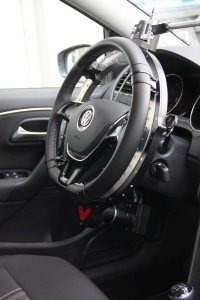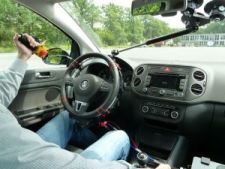Electronic Stability Control (ESC) Test
- Home
- Applications
- ESC Testing
Our steering robots are made for ESC testing.
For over 10 years, our VEHICO steering robots have been used to test ESC systems.
The Electronic Stability Control ESC is an active safety system, which improves the dynamic stability of the vehicle. Through selective brake interventions at individual wheels ESC keeps the vehicle on track and prevents it to skid uncontrollably.




Test Equipment
The steering angle accuracy required for the test with simultaneous extreme steering angle speeds of up to 1200 degrees per second can only be met by a steering robot. For the test we recommend our VEHICO steering robot CS-B50 or CS-B60 in combination with a suitable sensor system.
Thanks to the installation of our steering robot behind the vehicle steering wheel, it does not have to be removed for installation. Since the entire space in front of the steering wheel remains free, the safety-critical area between the steering wheel and the driver is not affected, nor is the driver's operation of the vehicle.The original steering wheel remains untouched, so that no complex steering wheel adapter production is necessary and the vehicle electronics located in the steering wheel also remain unaffected. The VEHICO steering robot can be installed in almost any commercially available test vehicle in a very short time.

Due to the freely configurable CAN interface our steering robot operates together with all popular sensor systems as long as they have a CAN interface. Even reading the vehicle's CAN signals is possible without difficulties. The steering robot can be equipped with up to two independent CAN bus interfaces. All on the steering robot configured CAN channels can be displayed in real time and logged synchronously with up to 200Hz.
Current Guidelines
According to the regulation FMVSS126, ESP is mandatory for all newly registered passenger cars in the USA as of 2012. This regulation has been transferred to the United Nations regulation ECE R13H, which applies to the European member states and many countries in Asia.
Accordingly, all newly registered passenger cars in Europe must be equipped with ESP from 2014.
Since 2011, Euro NCAP has also included ESP in the scoring.

Test Description
Both for the approval tests according to FMVSS126 and ECE R13H and at EuroNCAP, the systems are examined and assessed with the "sine with hold time" test manoeuvre.
For this purpose, the vehicles are always subjected to the same steering angle but with increasingly higher amplitudes. At a vehicle speed of 80 km/h, steering angles of up to +/-270 degrees are driven. A test run can thus have up to 60 test runs.

Test Procedure
Even with built-in steering robot the driver can operate the vehicle as normal. The vehicle is accelerated by the driver up to the desired speed. At a suitable location on the test track, the "Sine with Dwell" maneuver is triggered. Therfore the driver takes both hands off the steering wheel and keeps pressed a security button with both hands.
Only then the steering robot will be activated and continues operating until the maneuver is completed successfully, or the driver releases one of the two hand buttons. This allows a targeted manual intervention of the driver to stabilize a vehicle that tends to roll over during the maneuver.

Contact
Contact us
Do you have further questions or need more information?
We will be pleased to help you.
Contact us or one of our Salespartner.
Phone
+49 531 20835 110
